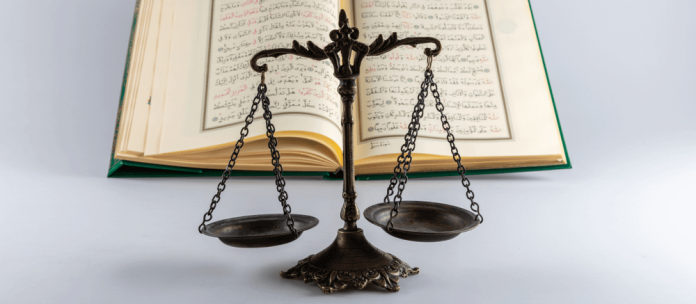This article is written by Suryansh Singh and updated by Gautam Badlani. This article mainly discusses the various schools of Muslim law.
It has been published by Rachit Garg.
Table of Contents
Introduction
The Muslim Law is based on the teachings of the Quran and Prophet Mohammad. In all the circumstances where the explicit command is provided, it is faithfully provided but there have been many areas which are not covered by these sources and as a result, the great scholars had themselves devised their interpretation of what should be done in such a situation.
As these scholars provided their interpretations (Qiyas) regarding the Muslim Law, it led to various opinions among many of them and out such difference, different schools of Muslim Law originated. Each school has its own explanation and reasons for their interpretation and it often leads to conflict in judgments.
In the absence of express rules, it cannot be said that one school is better or higher positioned than other school and thus all the schools have been accepted as valid and if a person follows any of these schools, he is considered to be on the right path.
The Muslim personal law has a rich jurisprudential history because it is based on many admirable and revolutionary concepts. It introduced the concept of inheritance rights for women and was the first to recognize divorce by mutual concept. Many of these concepts have now been incorporated in the modern day legal systems.
Historical development of Muslim Law
The development of the Muslim Law can be largely classified into 5 different period. These are
622 to 632 AD
This period, also known as the Hazira era, refers to the last 10 years of Prophet’s life. This period began when the Prophet and his followers left Mecca and moved to Madina. The Prophet made divine revelations during this period and legislations were made based on these revelations.
632 to 661 AD
This period is also known as the Caliphate period. This period covers the 30 years after the death of the Prophet. During this period, first 4 Caliphs of Islam were elected. During this period, the divine communications of the Prophet were collected and organized into the holy book, Quran.
661 to 900 AD
The Islamic jurisprudence developed during this period. Two important developments during this period were that the office of the Caliph was made hereditary and the seat of Caliphate was shifted to Damascus.
900 to 1924 AD
During this period, the Shia and Sunni schools were established. This period witnessed scientific development of Islamic jurisprudence. The 4 Sunni schools were founded during this period. However, at th later part of this phase, the development of jurisprudence was stagnated. Law was framed on the basis of Ijtihad, that is, the collective interpretation of the jurists.
1924 AD to the present
In 1924 AD, the office of the Caliphate was established and the period after 1924 constitutes the fifth phase of the historical development of Islamic law. During this period, law was developed by Muftis, Moolah and Maulvis. In many Islamic countries, attempts have also been made to codify the Islamic law.
Shia and Sunni division
After the death of the Prophet, there was a dispute regarding the manner in which his successor should be chosen. One group was of the opinion that the successor of the Prophet should be elected. This sect is known as the Sunni sect. Abu Bakr was elected as the first Caliph and was chosen to head the Muslim community. The Sunni sect supports the election method on the ground that the Prophet had himself suggested that hisssuccessor would be chosen by election.
However, some people, including the Fatima, the daughter of the Prophet, believed that the successor of the Prophet should be based on succession. This group constituted the Shia sect. This group declared Ali, the son-in-law of the Prophet to be the first Imam.
Schools under Muslim Law
In Islam, the people have been divided into two sects having different views regarding certain aspects of Islam. Thus, the schools of Muslim law can be broadly classified into two categories:
- Sunni Schools
- Shia Schools
Sunni Schools
There are 4 different schools under the Sunni sect. These schools are based largely on the same principles and differ only on minor aspects. There are 4 sources of Muslim law. These 4 sources are the Quran, Ijma, Sunna and Qiyas. The differences in the 4 schools emerged because of the difference in the degree of reliance placed on the different sources. However, all the schools recognize the relevance and importance of all these 4 sources. The different schools of the Sunni sect are:
In Sunni sect, there are four major schools of Muslim law which are as follows;
A. Hanafi School
Hanafi School is the first and the most popular schools in Muslim law. Before being named Hanafi, this school was known as Koofa School which was based on the name of the city of Koofa in Iraq. Later, this school was renamed as Hanafi School based on the name of its founder Abu Hanafee.
The Prophet had not allowed his words and traditions from being written, the Hanafi School relied on the customs and decisions of the Muslim community. Thus, Hanafi School codified the precedent which in prevalence during that time among the Muslim community.
The founder of this school Abu Hanafee had not written any book for laying down the rules of this school and therefore this school had grown through his two disciples- Imam Muhammed and Imam Abu Yousuf. Both of them gave to the Juristic preference (Isthi Hasan) and codified the Ijma’s of that period.
This school became widely spread in various territories, as a result, the majority of Muslims in countries such as India, Pakistan, Syria, and Turkey belong to Hanafi School. In India, since the majority of Muslims are from Hanafi School, the Courts decide the case of a Sunni Muslim as per the Hanafi School unless it is specified that they belong to other schools.
In Hanafi School, Hedaya is the most important and authoritative book which was created over a period of 13 years by Ali bin Abu Baker al Marghinani. This book provides laws on various aspects except for the law of inheritance. Lord Warren Hasting tries to translate the Hedaya to English. He appointed many Muslim Scholars to translate the book.
But the Sirajiyya is considered as the authoritative book of the Hanafi Law of Inheritance. The book is written by the Sheikh Sirajddin, and the first English translation is written by Sir William Jones.
Under the Hanafi School, children are have an obligation to maintain their parents. Under indigent circumstances, the parents have the right to claim maintenance from their children. Similarly, the grandparents can also seek maintenance from the grandchildren. However, it is pertinent to note that the mother has a better title than the father when it comes to claiming maintenance from the children.
Custody of children
Under the Hanafi school, the custody of a son lies with the mother until the son attains the age of 7 years. In case of a daughter, the mother has the custody till the daughter attains puberty. However, once the son attains 7 years of age or the daughter reaches puberty, the father is considered to be the natural guardian.
In Abdul Kalam v. Akhtari Bibi (1987), there was a dispute relating to the custody of a minor son. The parties were governed by the Hanafi School of Mohammedan Law. The mother claimed the custody of the child under Section 25 of the Guardians and Wards Act, 1890. Section 25 states that when a child is removed from his guardian’s custody and the court finds that the welfare of the child lies in him being restored to the custody of the guardian, the court may make an order to this effect.
The appellants had pleaded that since under the Muslim personal law, the father is considered to be the natural guardian of the Child, Section 25 of the Guardians and Wards Act does not apply to a Muslim Child.
Rejecting this argument, the Orissa High Court held that the interest of the child is of paramount consideration while deciding the issue of guardianship. The Court held that the Guardians and Wards Act applies to Muslims as well and thus, the mother was entitled to claim guardianship of the minor child under Section 25 of the Act.
Legitimacy of child
Both the Sunni as well as Shia schools provide that if a child is born within a specific time period from the dissolution of the marriage, then he would be considered valid. However, this time period varies from school to school. Under the Hanafi school, the child is considered to be legitimate if it is born within a period of 2 years from the dissolution of marriage.
B. Maliki School
This school gets its name from Malik-bin-Anas, he was the Mufti of Madeena. During his period the Khoofa was considered as the capital of Muslim Khaleefa where Imam Abu Haneefa and his disciples flourished with Hanafi Schools. He discovered about 8000 traditions of Prophet but complied only about 2000 of them. When the disciples of Imam Abu Haneefa codified their law based on Ijma’a and Isthihsan.
The maliki school gives the importance to the Sunna and Hadis whereas the Hanafi school gives the importance to the people and Isthihsan. As per Maliki School and Law, they rarely accept the Ijma’a. As per the Law, the person gave Fatwa challenging the sovereign authority of Khaleefa, he faced enmity and of lack of support from Muslim governments. Thus, this Maliki school did not get much popularity.
In India, there are no followers of this school but when the Dissolution of Muslim marriage act 1939 came in the picture, some of the laws and provision of this school was taken in account as they are giving more rights to the women than any other school. In Hanafi School, if the women not get any news of her husband, she has to wait till 7 years for Dissolution of the marriage, whereas in Maliki School the women have to wait 2 years for Dissolution of the Marriage.
Mu-atha of Imam Malik is considered as the most authoritative book of the Maliki School. This book is also the first book written on the Hadis in Islam and this book is considered as the authority over all Muslims in the World.
Unlike the Hanifi school, the Malike school believes that traditions are the most important source of law. This school emphasizes that the rules of law should be based on traditions.
Imam Malik-ibn-Anas
Imam was a lecturer on traditions and he was also a jurist. He is recognized as one of the most brilliant minds and he had vast knowledge of Sunna or traditions. Malik as well as other propounders of this school were also judges and solved the day-to-day problems of the people. Thus, the approach of this school was to make the law more practicable.
Imam relied on the traditions and usages of the Prophet to interpret the law. He also belived on the concept of muslahat which means public welfare.
Legitimacy of child
Under the Maliki school, a child born after the dissolution of the marriage is considered legitimate if it is born within a period of 4 years from the dissolution of the marriage.
It is interesting to note that Section 112 of the Indian Evidence Act, 1872 also deals with the legitimacy of a child born after dissolution of marriage. Under the Evidence Act, the child would be considered legitimate if it is born within a period of 280 days of the dissolution of marriage. Moreover, the mother should be unmarried at the time of the birth of the child. Thus, we see that there may be a situation where a child may not fulfill the criterion of legitimacy laid down under the Evidence Act, but might still be recognized as legitimate under the Maliki school.
C. Shaffie School
The Shaffie School gets its name on the name of Muhammad bin Idris Shaffie, his period was between 767 AD to 820 AD. He was the student of Imam Malik of Madeena. Then he started working with the disciples of Imam Abu Haneefa and went to Khoofa.
He conclude the idea’s and the theories of Hanafi School and Maliki School in a friendly manner. The Imam Shaffie was considered as one of the greatest jurist of Islam. He created the classical theory of the Shaffie Islamic Jurisprudence.
According to this school, they considered Ijma’a as the important source of the Muslim law and provide validity to the customs of the Islamic people and follows more methods of Hanafi School. the main contribution of Shaffie School is the Quiyas or Analogy.
The Al-Risala of Imam Shaffie was considered as the only authoritative book of Islamic Jurisprudence. In that book they discuss and interpret the Ijma’a (Consensus), Quiyas (Analogy), Ijthihad (Personal reasoning) Isthihsan (Juristic preference) and Ikhthilaf (Disagreement) in separate chapter in his book Risala. His other book Al-Umm is the authority on Fiqh (science of way of life).
The followers of Shafie School are spread in Egypt, Southern Arabia, South East Asia, Indonesia and Malaysia.
D. Hanbali School
The Ahmad bin Hanbal is the founder of the Hanbali School. He found the Hanbali school in 241 (AD 855). He is the disciple of Imam Shaffie and supports Hadis. He strongly opposed the Ijthihad methods. He introduced the theory of tracing the root of Sunna and Hadis and try to get the answer all his question. His theory was to return to the Sunna of the Prophet. When the Imam Shafie left for Baghdad, he declared that the Ahmad bin Hanbal was the only one after him who is the better jurist after him. The followers of Hanbali school found in Syria, Phalastine and Saudi Arabia.
Imam Abu Abdullah Ahmed-Ibn-Hanbal
Imam Abu Abdullah Ahmed-Ibn-Hanbal established the Hanbali school. He was born in Baghdad. He was a rigid tradtitionalist and have utmost importance to the traditions. He considered traditions to be more important than the other sources.
Even though he rigidly relied upon the traditions, he interpreted the traditions in a liberal manner.
Shia Schools
As per Shia Sect, there are three schools of law. Shia Sect is considered as the minority in the Muslim world. They enjoy the political power only in Iran though they don’t have the majority in that state also.
A. Ithna-Asharis
These schools are based on the following of Ithna-Ashari laws. The followers of these schools are mostly found in Iraq and Iran. In India also there is the majority of the shia muslim who follows the principles of the Ithna-Asharis School. They are considered political quietists. This school is considered as the most dominant school of the shia muslims. the ja’fari fiqh of the shias in most cases indistinguishable from one or more of the four sunni madhahib, except mutah is considered as the lawful marriage. The people who follow the Ithna Asharis school believe that the last of the Imams disappeared and to be returning as Mehdi(Messiah).
B. The Ismailis
According to Ismailis school, in India there are two groups, the Khojas or Western Ismailis represents the followers of the present Aga Khan, who they considered as the 49th Imam in this line of Prophet, and the Bohoras i.e. the Western Ismailis are divided into Daudis and Sulaymanis.
The Bohoras and Khojas of Mumbai are considered as the followers of this school. It is considered that the follower of these schools has special knowledge of religious doctrine.
C. Zaidy
The followers of this school are not found in India but are maximum in number in South Arabia. This sect. of the shia school is the most dominant among all in Yemen. The followers of these schools are considered as political activism. They often reject the twelver shia school philosophies.
Other schools
Besides the schools under Shia and Sunni sects, there are some other schools which are also present which are:
Ibadi School
Ibadi is a school which belongs neither to the Shia nor Sunni sect and this school claim that its history traces back to the times of 4th Khaleefa Ali. The Ibadi school gives more preference to the Quran and they do not give the Sunna much importance. This school has its followers in Oman. One of the most important points about this school is that besides the Quran, it has provided principal consideration to Ijtihad (personal reasoning) which has been partially accepted by the Sunnis and has been completely rejected by the Shias.
Ahmadiya School
The followers of Ahmadiya school claim to be Muslims but they do not follow Prophet Muhammed. This school has a recent origin and they are followers of one Ahmed who was alive in the 19th century.
This school is said to have a British-Indian origin and Mirza Ghulam Khadiani is the founder of this school, who served the British Government. Even though this school claims to be a follower of Islam, none of the Muslim Government has accepted them as Muslims because they believe this school’s faith is completely against the faith of Muslims.
The Khadiyan village which is situated in Punjab in India is said to be the birthplace of Ahmed and thus it is their holy place and the followers are also known as Kadhiyani. There is no authoritative book of this school and because its origin is also recent, it has no recognition by the other authoritative books of Islam.
There are many differences between the Ahmadiya School and Muslims therefore, they are not regarded as part of Islam. The major points of difference between them are as follows:
- The Muslims believe that Prophet Mohammad was the Messenger of God on Earth and he was the last Prophet who had spoken with God. Thus, his teachings are an important part of the lives of Muslims but the Ahmadiyas believe that God still communicates with his holy servants even after Prophet Mohammad.
- The Ahmadiyans claim that the list of Prophets before Mohammad includes Buddha, Krishna, Zoroaster and Ramchandra and they claim it is according to the Quran but the non-Ahmadiyans do not accept such claims and refuse to acknowledge them as Prophets.
- Unlike the Muslims, the Ahmadiyans do not accept the claim of the Sultan of Turkey as the Caliphate and they claim that every Muslim person should remain loyal to the Government of their country.
- While Muslims believe that Mahdi will have a holy war or Jihad and Islam will be spread by the sword, the Ahmadiyas believe that it will be spread by arguments and heavenly signs and not through violence.
Conclusion
Muslim law is governed by the teachings of the Quran and the Prophet Mohammad. There have been many different schools which follow their own interpretations of these teachings on points on which the Quran is silent. While the major schools of Muslims can be divided under the two sects of Shia schools and Sunni schools, even the schools under these sects have been further divided into various schools.
Each school has its own beliefs and practices and because is no set rule regarding the matters on which the Quran is silent, one school cannot be said to be better positioned than the other schools and thus even though there are many schools in Muslim law, they all lead to one path. Thus, the teachings of these schools can be compared to different paths which all lead to the same destination.
Frequently Asked Questions (FAQs) (to be added after conclusion)
What is the Mahr and what is the amount of Mahr prescribed under the various schools?
Mahr is the sum of money which a wife receives, under Muslim law, from her husband upon getting married. The different Schools provide for different value of Mahr. Under the Hanafi law, the minimum amount of Mahr is 10 dirhams. Under the Maliki Law, the minimum amount is 3 dirhams. Shia law does not prescribe any minimum amount of Mahr but the maximum Mahr cannot excel 500 dirhams.
What are the primary sources of Muslim law?
The primary sources of Muslim law are the Quran, Ahadis, Qiyas and Ijma.
Quran is the holy book of the Muslims. Ahadis refers to what was said by the Prophet.
Ijma refers to the consensus of the Muslim jurists. After the death of the Prophet, the jurists had to reach a consensus to solve the problems whose answers could not be found in the principles of the Quran or the Sunna. The consensus reached by the jurists is known as Ijma.
Qiyas refers to a process of analogical deduction. All the Sunni schools agree that if any matter has not been provided in the Quran, Sunna and the Ijma, then such matters have to be determined by analogical deduction of what has already been provided in the three sources.
References
Students of Lawsikho courses regularly produce writing assignments and work on practical exercises as a part of their coursework and develop themselves in real-life practical skills.
LawSikho has created a telegram group for exchanging legal knowledge, referrals, and various opportunities. You can click on this link and join:
Follow us on Instagram and subscribe to our YouTube channel for more amazing legal content.
 Serato DJ Crack 2025Serato DJ PRO Crack
Serato DJ Crack 2025Serato DJ PRO Crack











 Allow notifications
Allow notifications



